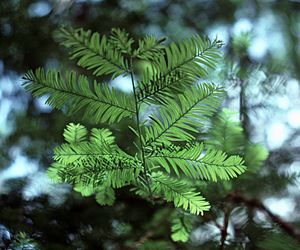Florida yew facts for kids
Quick facts for kids Florida yew |
|
|---|---|
 |
|
| Conservation status | |
| Scientific classification | |
| Genus: |
Taxus
|
| Species: |
floridana
|
 |
|
| Natural range | |
The Taxus floridana, also known as the Florida yew, is a special kind of yew tree. It grows only in a very small area in northern Florida. You can find it on the eastern side of the Apalachicola River. It lives in forests that are about 15 to 40 meters (50 to 130 feet) above sea level.
This tree is considered critically endangered. This means it is in great danger of disappearing forever. It is protected in special places like Torreya State Park. It is also found in the Apalachicola Bluffs and Ravines Preserve. Laws in the United States and Florida help protect this rare plant.
Contents
About the Florida Yew
The Florida yew is an evergreen shrub or a small tree. Evergreen means it keeps its leaves all year round. It can grow up to 6 meters (about 20 feet) tall. Sometimes, it can even reach 10 meters (33 feet). Its trunk can be up to 38 centimeters (15 inches) wide.
The bark of the Florida yew is thin and scaly. It has a purple-brown color. Its branches grow in different directions. New shoots are green at first. After a few years, they turn brown.
Leaves and Cones
The leaves are thin and flat. They are slightly curved, like a sickle. Each leaf is about 1 to 2.9 centimeters (0.4 to 1.1 inches) long. They are also 1 to 2 millimeters wide. The tips of the leaves are a bit blunt. The leaves grow in a spiral pattern on the shoots. However, they twist at the base to look like they are in two neat rows.
The Florida yew is a dioecious plant. This means it has separate male and female plants. The male and female cones grow on different trees. The female seed cone is very unusual. It looks like a berry. It has a soft, juicy red part called an aril, which is about 1 centimeter (0.4 inches) wide. Inside, there is a single dark brown seed. These "berries" grow one by one in the leaf corners.
The male cones are round and about 4 millimeters (0.16 inches) wide. They grow on the underside of the shoots in early spring.
How it's Different
The Florida yew grows in the same area as another rare plant, the Torreya taxifolia. They look similar. However, you can tell them apart. The Florida yew has shorter leaves with blunt tips. The Torreya taxifolia has spine-tipped leaves. Also, the crushed leaves of the Florida yew do not smell as strong.
It can be hard to tell the Florida yew from other yew species. Some people used to think it was a type of Taxus baccata.
Life and Habitat
The Florida yew grows slowly. It likes soil that is a little bit acidic. It also prefers partial shade. You can often find it on north-facing slopes. This tree is very sensitive to fire. It can also grow well in shady areas.
Where these trees grow can depend on the soil, the direction of the slope, and how much moisture is in the air. There isn't a specific plant that always grows near it.
Growing and Reproduction
The Florida yew can handle cold weather down to USDA zone 8. This means it can survive winters where the lowest temperature is about -12 to -7 degrees Celsius (10 to 20 degrees Fahrenheit).
You can grow new Florida yew plants from cuttings or from seeds. The seeds need a special treatment called scarification to help them sprout. This plant can also spread by layering. This is when a branch touches the ground and grows roots. It can also sprout new stems from its base. Birds like to eat the cones of the Florida yew. They also dig into the stems to find insects.
Uses of the Florida Yew
The bark of the Florida yew contains a special substance called paclitaxel. This substance is used in medicine to help fight many types of cancer.
However, it is very important to know that the seeds and leaves of the Florida yew are poisonous to humans if eaten. So, you should never eat any part of this plant.
Threats to the Florida Yew
The Florida yew faces several dangers. White-tailed deer can rub against and eat the small stems. Beavers also use the yew as a food source. Some populations of the Florida yew are in areas where logging and building are happening.
The biggest problems are that its habitat is being damaged. Also, new plants are not growing well. This means that very few new Florida yew trees have started growing in the last few decades. This greatly affects how many trees are left. Some groups of Florida yew trees are on private land that is not protected. These trees are especially at risk.



